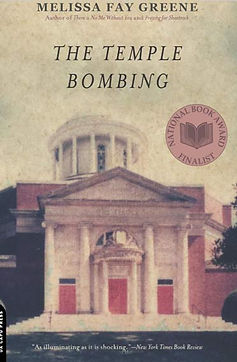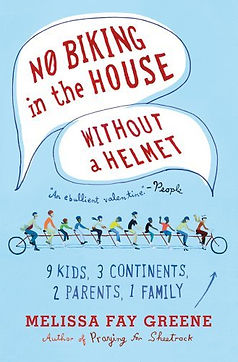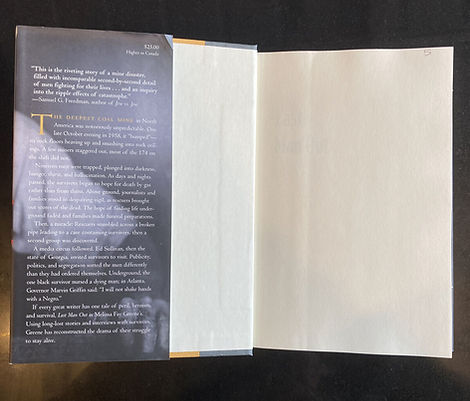
Melissa Fay Greene
Melissa Fay Greene
Non-fiction Writing and the Particularity of Place
with Robert Stalker







Books by Melissa Fay Greene
Vladimir Nabokov famously advised readers to “notice and fondle detail.” Melissa Fay Greene has consistently brought a similar commitment to her reporting and writing. Throughout a long and distinguished career, her award-winning articles and books have tackled a wide range of topics, from the exploration of abandonment and trauma on the ability to form emotional attachments to the legacy of racism and violent extremism in the American South. What remains consistent throughout her work is a grounding in the particularity of place and the significance of individual, human stories.
Born in Macon, Georgia, and raised in Dayton, Ohio, Greene returned to Georgia in adulthood and has lived in the state for years, much of that time as a resident of Atlanta. The Kirk Writer-in-Residence at Agnes Scott College, Greene instructs her students to look for “large and important things happening in a very little place,” an injunction she follows in her own work. In her first nonfiction book, Praying for Sheetrock (1991), Greene tackles the issue of racism in the South by focusing on a rural county on the Georgia coast. The book was a National Book Award finalist and named one of the “100 Best Works of American Journalism of the Twentieth Century” by a panel convened by New York University. Her next book, The Temple Bombing, explores the bombing of Atlanta’s oldest synagogue. A gripping and chilling narrative about the state’s and the country’s legacy of bigotry and hate, the book was a National Book Award finalist and winner of the Southern Book Critics Circle Award, among other prizes. Her next book, Last Man Out (2002), would seem at first blush to be something of a departure, focusing as it does on the 1958 mining disaster in Nova Scotia, Canada. The book’s investigation of the heroic rescue of the miners, however, lands Greene closer to home when the survivors are invited to Georgia to be feted by the mayor and the titular “last man out” turns out to be Black Nova Scotian Maurice Ruddick. Georgia’s then segregationist policies insulted the Canadian hero, creating a very public embarrassment for the state’s officials. Last Man Out was named Best Book of the Year by multiple news outlets and reviewers. Greene is an inductee in the Georgia Writers Hall of Fame and recipient of the John Simon Guggenheim Fellowship in the Creative Arts.
Greene and her husband, Don Samuel, are parents to nine children, four biological and five adopted. She is a passionate advocate for adoption and has written informatively about the process and its challenges. She has written about her own family on occasion, but it wasn’t until 2009 that she addressed the struggles and rewards of child-rearing directly, in her humorous and touching memoir NO Biking in the House Without a Helmet.
Robert Stalker, Atlanta, 2023


Last Man Out, Springhill Mine Disaster, by Melissa Fay Greene
Robert Stalker: You begin your very funny Smithsonian Magazine article about Atlanta, “Some Don’t Like It Hot” (2007), with an adage about the city I’d never heard: “It’s a nice place to live, but you wouldn’t want to visit there.” What did you mean? How did you come to settle in Atlanta and what do you like most about the city?
Melissa Fay Greene: I was born in Macon, spent my school years in Ohio, and returned to Georgia immediately after graduating from Oberlin College. I moved first to Savannah, later to Athens, and later still to Rome, before finally—with my husband, criminal defense attorney Don Samuel, and baby daughter Molly Samuel (now Deputy Managing Editor of [Atlanta public radio station] WABE)—settling in Atlanta. We’ve been here 41 years. When I lived on the coast and made the occasional drive across Middle Georgia to visit Atlanta, the city glowed on the horizon like Emerald City in The Wizard of Oz, in brilliant contrast to everything we’d spent the last four hours driving through. I think I still retain that feeling a bit: that this is the magical city in which everyone is welcome and everything happens. BUT: sending visitors to shlep up Stone Mountain in July or, worse, staggering up the granite with them, is just hard. You end up wishing these nice out-of-towners had chosen to visit New Hampshire instead. You hiss at your husband, while they’re in another room: “July? They had to visit Atlanta in July?”
RS: In a Paris Review interview on “The Art of Nonfiction,” Geoff Dyer insists that “the techniques are pretty much the same in fiction and in nonfiction.” Your books have a strong sense of place and character, a novelist’s eye for detail, and strong narrative drive. In the Afterword to Last Man Out (2003), your book about the Springhill mine disaster, however, you make a point of saying that “This is a work of nonfiction. I did not make up these words, scenes, or stories. They are events I learned from the voices of survivors.” You went through painstaking efforts to establish the identities of the trapped miners and to visit the very mines in Nova Scotia to capture the “vivid impression of chambers of coal and the utter absence of light.” Do you make a sharp distinction between fiction and nonfiction? How do you see the relation between the two?
MFG: Good heavens, yes, I make the sharpest distinction between fiction and nonfiction! I have the honor of teaching undergraduate journalism at Agnes Scott College in Atlanta and in the Narrative Nonfiction MFA program at UGA’s Grady College of Journalism. The Grady faculty members joke that our unofficial motto is “We don’t make shit up.” A writer’s power to enlarge to the tenth power, in prose, a crowd that actually consisted of a few idle onlookers and maybe an ice cream truck; or to supply silver-tongued remarks to a protagonist who, in reality, stood dumbstruck at the historic moment; or to stage more dramatic weather (the “objective correlative” of an emotion in T.S. Eliot’s framing) at an important turning-point when the actual weather on that date offered only a light haze are all the temptations of a novelist. When you commit to nonfiction, you commit to reporting and to describing, to the greatest possible degree, what really happened to some people at some time. Not what you imagine might have happened. Not what, in your view, would have made a better story, had it happened. Not what delivered to everyone their just desserts, if it had been up to you. But what—in all its infuriating complexity and loose ends and disappointing let-downs—seems to have actually happened. Blurring those lines robs nonfiction of its greatest power: the power to say this—as close as I can capture it—happened to those people in that situation at that time and place and here's what they made of it and how they felt about it.

Last Man Out, Springhill Mine Disaster, by Melissa Fay Greene
RS: Praying for Sheetrock (1991), your award-winning book on McIntosh County, Georgia, contains an epigraph from Savannah attorney Sonny Seiler: “You can’t learn anything riding down I-95 with the Yankees. You’ve got to go the old way, 17, what we call the old way.” I’m wondering if you see in the epigraph something akin to your own approach to storytelling.
MFG: First, amazing timing to this question, as the inimitable, irrepressible Frank W. "Sonny" Seiler died this week at the age of 90. Savannah attorney and owner of all the UGA mascot bulldogs named Uga, he was a great source to me for Sheetrock and a great friend and colleague to my husband over the years (including in the murder trials that inspired the book Midnight in the Garden of Good and Evil) (… speaking of mixing fact and fiction.) And yes, I think his epigraph stands for my approach and that of most other journalists! It’s a warning that becomes more relevant every day, with the pandemic-like buyouts and closures of small-town newspapers across the country, which leaves local and regional reporting to coastal news-show hosts and half a dozen national newspapers: the equivalent of “riding down I-95 with the Yankees.”
RS: Your story for The Atlantic, “Can an Unloved Child Learn to Love?” (2020), covers a lot of ground, balancing history, psychology, and a profile of Romanian orphan Izador Ruckel. How did you come to, as you’ve said, “venture into the melancholy landscape” of adults who had been raised as “irrecoverables” in Ceausescu’s “child gulags?” How did you find Izador and how did you first approach him about doing a story?
MFG: My husband and I are the parents of nine––four by birth and five by adoption. In 1999, we adopted a four-and-a-half-year-old boy from a rural Bulgarian orphanage (in an era when it was easier and more transparent to adopt from abroad than from American foster care; the reverse is true now.) Bulgaria was not Romania, but it wasn’t good; and we saw some shocking scenes. I learned a lot from the parents adopting from the Romanian orphanages; online, and in some reporting for other pieces, I followed their trajectories and their heartbreaks for years. People who had been promised, by their naive adoption agencies, “Love is enough!” ended up writing memoirs with titles like, When Love is Not Enough. The “attachment” relationship––the vital early-in-life bonding of a baby with one or two caregivers––is everything. If it doesn’t happen on time, when the baby developmentally needs it, it’s almost impossible to ever close the gap. We were lucky in all our adoptions of older children that—though orphaned—they’d known love. But I never forgot the stories of some of those families who—again, naively, and without expert advice because no one knew much about it then—ended up trying to raise children who’d been deprived of “attachment figures” in infancy and early childhood. When I realized we were approaching the 30th anniversary of the overthrow of Soviet-Romanian dictator Nicolae Ceaușescu and the subsequent unveiling, to the world’s horror, of his gulag-like system of orphanages, it gave me a news-peg. I reactivated some of my 20-year-old contacts (though Yahoo Groups had disappeared – that’s where the adoptive parents of Romanian orphanage children used to meet online) and began informational interviews. I found willing parents right away, and several invited me to visit and meet their adult children, but most of the invitations came from families whose sons and daughters had been cognitively impaired by their brutal childhood. The challenge was to find a survivor capable of reflecting back upon orphanage life. I heard Izidor Ruckel’s name, found the memoir he’d self-published in his early 20s, and knew––probably four pages in–– that, if he would talk to me, I had found my protagonist. He generously consented.

Melissa Fay Greene with her family Photo: Marko Metzinger/Studio D; Bob Samuel
RS: In The Temple Bombing (1996), your book about the 1958 bombing of Atlanta’s oldest synagogue, you revisit the tragic story of Leo Frank, calling him “a short answer to a complex question, the true answer to which lay in antebellum––even colonial––economic and social arrangements.” Do you think that we are, as a culture, any closer to asking complex questions about our history? What do you make of what looks like a very deliberate erasure of the economic and social arrangements in American history? What do you think has triggered the rise in antisemitism in our country and across the globe?
MFG: The day after the Temple bombing, Ralph McGill, editor of the The Atlanta Journal-Constitution, published an editorial attacking Southern elected officials who conjured up scapegoats and stirred up the mobs for their own political gains: “It is not possible to preach lawlessness and restrict it,” he wrote. “You do not preach and encourage hatred for the Negro and hope to restrict it to that field. It is an old, old story. It is one repeated over and over again in history. When the wolves of hate are loosed on one people, then no one is safe.”
Obviously, these days the former president and his clones find it benefits them to distract their “base” from the authentic sources of their suffering—like income and wealth inequality and the climate crisis, which could lead to demands for real change––by directing their rage towards immigrants, queer people, pregnant women, and librarians. Like McGill said, scapegoating is an old, old story and today’s GOP did not invent it. Historically, when this strategy is applied in Western countries to distract and generate in-fighting among citizens, while powerful people pursue their own ends, the Jews are named. It’s the same today.

Melissa Fay Greene is an American nonfiction author. A 1975 graduate of Oberlin College, Greene is the author of seven books of nonfiction, a two-time National Book Award finalist, a 2011 inductee into the Georgia Writers Hall of Fame, and a 2015 recipient of the John Simon Guggenheim Fellowship in the Creative Arts. Greene has written for The New Yorker, The New York Times, The Washington Post, New York Magazine, Newsweek, Life Magazine, Good Housekeeping, The Atlantic, Reader's Digest, The Wilson Quarterly, Redbook, MS Magazine, CNN.com and Salon.com. Greene currently resides in Atlanta, Georgia.
Melissa Fay Greene

Robert Stalker is an Atlanta-based freelance arts writer.
Robert Stalker